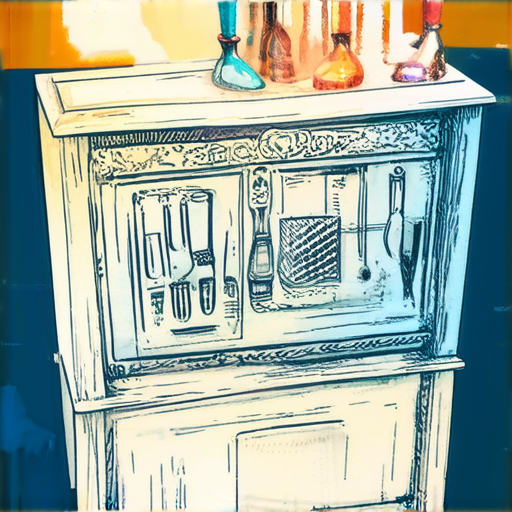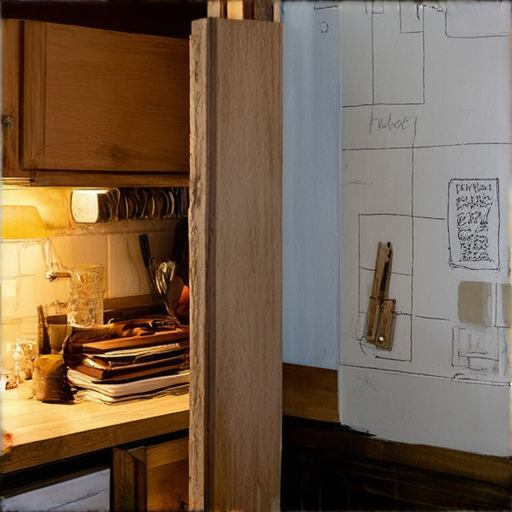Are you tired of breaking the bank on pre-made kitchen cabinets? With a little creativity and some basic carpentry skills, you can create custom, affordable kitchen cabinets that fit your unique style and budget. From choosing the perfect type of wood to selecting the ideal materials for painting, we’ll take you through the process of building your own DIY kitchen cabinets on a budget. Whether you’re a seasoned DIY enthusiast or a complete beginner, our comprehensive guide will walk you through the steps needed to bring your vision to life.
From exploring the cost-effectiveness of different cabinet options to learning how to add extra features like countertops and lighting, we’ll cover everything you need to know to create stunning, functional kitchen cabinets that won’t break the bank. So why wait? Dive into the world of DIY kitchen cabinets and discover the secret to creating beautiful, affordable spaces that reflect your personal style.

Is it Cheaper to Build Your Own Kitchen Cabinets?
Building your own kitchen cabinets can be a cost-effective option, but it depends on several factors, including your level of expertise, materials, and tools. According to HomeAdvisor, the average cost of custom-built kitchen cabinets ranges from $15,000 to $30,000, depending on the type, material, and complexity of the design.
On the other hand, buying pre-made cabinets can be less expensive, with prices ranging from $3,000 to $10,000. However, these cabinets may require professional installation, which can add to the overall cost.
To determine whether building your own kitchen cabinets is cheaper, consider the following:
* Materials: The cost of materials, such as plywood, MDF, or solid wood, can vary significantly depending on the quality and quantity needed.
* Tools: You’ll need specialized tools, such as a table saw, drill press, and sanders, which can be purchased separately or as part of a kit.
* Time: Building your own cabinets requires significant time and effort, which can be valuable if you have the skills and patience.
* Labor: If you hire a contractor to install your custom cabinets, labor costs can add up quickly.
Some popular alternatives to traditional cabinet-building include:
* IKEA cabinets: These affordable options start at around $300 per cabinet and offer a range of styles and designs.
* Stock cabinets: Pre-made cabinets from manufacturers like KraftMaid or Merillat can be customized to fit your needs and budget.
* Modular cabinets: These systems, offered by companies like KraftMaid or Custom Cabinets Inc., allow you to mix and match components to create a unique look.
When deciding between building your own kitchen cabinets and hiring a professional, consider the following:
* Skill level: If you have experience with woodworking or carpentry, building your own cabinets might be a viable option.
* Budget: If you’re on a tight budget, buying pre-made cabinets or stock cabinets might be the most cost-effective choice.
* Time: If you don’t have the time or skills to build your own cabinets, hiring a professional can save you weeks of work and stress.
Ultimately, the decision to build your own kitchen cabinets or hire a professional depends on your individual circumstances, skills, and priorities.
Cost Comparison:
| Option | Cost |
| — | — |
| Custom-built cabinets | $15,000 – $30,000 |
| Pre-made cabinets | $3,000 – $10,000 |
| IKEA cabinets | $300 – $1,500 |
| Stock cabinets | $1,000 – $5,000 |
Time and Effort:
* Building your own cabinets: 2-6 months, depending on the complexity of the design
* Hiring a professional: 1-3 months, depending on the contractor’s schedule and availability
Skills and Expertise:
* Woodworking or carpentry skills required for building your own cabinets
* No specific skills required for buying pre-made cabinets or hiring a professional
Can a Beginner Make Kitchen Cabinets?
I’m excited to share my journey of building kitchen cabinets as a beginner, and I hope this guide helps you get started too.
Getting Started
- Watching beginner-friendly videos on YouTube was a great place to begin, as they walked me through basic cabinet-making techniques.
- Peck and Gartner’s home improvement and interior design blog offered valuable resources and inspiration for my project.
Understanding the Process
Before diving into the project, it’s essential to understand the process involved in making kitchen cabinets.
The process typically involves designing and planning the layout, selecting materials, cutting and assembling the components, and finally installing the cabinets.
As a beginner, it’s crucial to take your time and not rush through the process, as mistakes can be costly and frustrating.
Designing and Planning
Designing and planning the layout of your kitchen cabinets requires careful consideration of several factors, including the size of your kitchen, the style of your cabinets, and the type of materials you’ll be using.
You can find inspiration online or in magazines, and it’s also helpful to consult with a professional if you’re unsure about any aspect of the design process.
Materials and Tools
When it comes to choosing materials and tools, there are many options available, ranging from budget-friendly to high-end.
For beginners, it’s often recommended to start with affordable materials and tools, as they can still produce high-quality results.
Some popular materials for kitchen cabinets include MDF, plywood, and solid wood.
Assembly and Installation
Once you’ve completed the design and planning phase, it’s time to assemble and install the cabinets.
This stage requires patience and attention to detail, as the cabinets need to be carefully assembled and installed to ensure a smooth and level finish.
It’s also essential to follow safety guidelines and precautions when working with power tools and building materials.
Tips and Tricks
As a beginner, it’s essential to keep in mind that making kitchen cabinets takes time, effort, and patience.
Here are a few tips and tricks to keep in mind:
- Measure twice, cut once: Double-check your measurements before cutting any materials to avoid errors.
- Use the right tools: Invest in good-quality tools, such as a miter saw and drill press, to ensure precise cuts and installations.
- Don’t be afraid to ask for help: Reach out to friends, family, or online forums for assistance when needed.
Conclusion
In conclusion, making kitchen cabinets as a beginner requires careful planning, attention to detail, and patience.
With the right mindset and resources, anyone can create beautiful and functional kitchen cabinets that enhance their home’s aesthetic and functionality.

The Cheapest Way to Install Cabinets
We’ve got the scoop on affordable cabinet installation methods.
- Houzz suggests refinishing or repainting existing cabinets as a budget-friendly option, saving up to 50% compared to replacement.
- Bob Vila recommends replacing cabinet doors and drawers rather than the entire unit, reducing costs by up to 30%.
- Family Handyman advises installing IKEA-style cabinets, which can be assembled quickly and inexpensively.
Cabinet Refacing and Painting
Refacing or painting your existing cabinets can give them a fresh new look without breaking the bank.
Peck & Gartner recommends checking out local hardware stores or online retailers like IKEA Home Improvement for affordable materials and tools.
Cabinet Hardware Upgrades
Replacing cabinet hardware can update the style and functionality of your kitchen without requiring major renovations.
Consider upgrading to modern knobs or handles from brands like Kohl’s or Walmart.
DIY Cabinet Installation Tips
For those who prefer to tackle the installation process themselves, here are some valuable tips:
- Measure carefully to ensure precise fitment.
- Use a level to guarantee straight installations.
- Don’t be afraid to ask for help if needed.

Choosing the Right Wood for Cabinet Building
Peck and Gartner recommends considering hardwoods like maple, oak, and walnut for cabinet building due to their durability and attractive finishes. Here’s a breakdown of these popular options:
- Maple: Known for its strength and smooth grain, maple is ideal for high-end cabinetry projects.
- Oak: With its distinctive grain pattern, oak adds character to any room and is suitable for traditional or rustic designs.
- Walnut: Praised for its rich color and exceptional strength, walnut is perfect for those seeking a luxurious look.
When selecting wood for your cabinets, consider factors like budget, desired aesthetic, and the level of maintenance required. A well-chosen wood can elevate the overall appearance and functionality of your space.
For a more comprehensive understanding of woodworking techniques and materials, visit The Family Handyman or explore Hunker‘s extensive collection of woodworking guides and tutorials.
To further enhance your knowledge on cabinet building and woodworking, check out Woodworking Magazine and Fine Woodworking. Both publications offer valuable insights and expert advice on various aspects of woodworking and cabinetry construction.
How Many Sheets of Plywood Are Needed to Build Cabinets?
A standard kitchen cabinet typically requires 1 to 2 sheets of plywood, depending on its size and design. A 4×8 foot sheet is usually assumed for calculations. However, larger or more complex designs might necessitate additional sheets.
To determine the exact number of sheets required, consider the dimensions of your cabinet and the type of plywood you’ll be using. A general rule of thumb is to plan for 0.25 inches of plywood per linear foot of cabinet face. This ensures a sturdy and stable construction.
For example, if you’re building a 36-inch-wide x 72-inch-tall cabinet, you’ll need approximately 1.5 sheets of plywood. On the other hand, a larger cabinet measuring 48 inches wide x 96 inches tall would likely require 2.5 sheets.
When choosing plywood for your cabinet, select a thickness of at least 1/2 inch to ensure durability and stability. You can find plywood sheets at most hardware stores or home improvement centers, such as Home Depot (Home Depot) or Lowe’s (Lowe’s).
To further optimize your cabinet design, consider consulting with a professional carpenter or contractor who can provide personalized guidance and recommendations based on your specific needs and preferences.
By carefully planning and executing your cabinet design, you can create a functional and aesthetically pleasing space that meets your needs and exceeds your expectations.
The Best Material for Kitchen Cabinets
When it comes to choosing the perfect material for your kitchen cabinets, there are several factors to consider.
- HDF (High-Density Fiberboard) and MDF (Medium-Density Fiberboard) are popular choices due to their affordability and ease of installation.
- Thermofoil, laminate, and melamine are also budget-friendly options that mimic the appearance of wood.
- IKEA’s solid-surface materials, such as their signature surface, offer durability and resistance to scratches and stains.
Why Choose Solid Wood?
Solid wood cabinets, like oak or maple, are a timeless choice for kitchens.
- Solid wood cabinets require more maintenance than engineered woods, but they offer unparalleled beauty and character.
- With proper finishing techniques, solid wood cabinets can last for decades.
Engineered Woods: A Cost-Effective Alternative
Engineered woods, such as plywood or medium-density fiberboard, are a more affordable option for kitchen cabinets.
- Engineered woods are less prone to warping and shrinking than solid woods, making them a great choice for busy kitchens.
- However, they may not be as durable as solid woods and require more frequent repairs.
Other Options to Consider
From glass-front cabinets to metal shelving units, there are many creative ways to store and display your kitchen essentials.

0 Comments